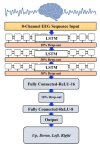Imagined Speech Classification Using EEG and Deep Learning
- PMID: 37370580
- PMCID: PMC10295790
- DOI: 10.3390/bioengineering10060649
Imagined Speech Classification Using EEG and Deep Learning
Abstract
In this paper, we propose an imagined speech-based brain wave pattern recognition using deep learning. Multiple features were extracted concurrently from eight-channel electroencephalography (EEG) signals. To obtain classifiable EEG data with fewer sensors, we placed the EEG sensors on carefully selected spots on the scalp. To decrease the dimensions and complexity of the EEG dataset and to avoid overfitting during the deep learning algorithm, we utilized the wavelet scattering transformation. A low-cost 8-channel EEG headset was used with MATLAB 2023a to acquire the EEG data. The long-short term memory recurrent neural network (LSTM-RNN) was used to decode the identified EEG signals into four audio commands: up, down, left, and right. Wavelet scattering transformation was applied to extract the most stable features by passing the EEG dataset through a series of filtration processes. Filtration was implemented for each individual command in the EEG datasets. The proposed imagined speech-based brain wave pattern recognition approach achieved a 92.50% overall classification accuracy. This accuracy is promising for designing a trustworthy imagined speech-based brain-computer interface (BCI) future real-time systems. For better evaluation of the classification performance, other metrics were considered, and we obtained 92.74%, 92.50%, and 92.62% for precision, recall, and F1-score, respectively.
Keywords: EEG decoding; LSTM; brain–computer interface (BCI); imagined speech; inner speech; wavelet scattering transformation (WST).
Conflict of interest statement
The authors declare no conflict of interest.
Figures









References
-
- Panachakel J.T., Vinayak N.N., Nunna M., Ramakrishnan A.G., Sharma K. Advances in Communication Systems and Networks. Springer; Berlin/Heidelberg, Germany: 2020. An improved EEG acquisition protocol facilitates localized neural activation; pp. 267–281.
-
- Abdulkader S.N., Atia A., Mostafa M.-S.M. Brain-computer interfacing: Applications and challenges. Egypt. Inform. J. 2015;16:213–230. doi: 10.1016/j.eij.2015.06.002. - DOI
-
- Abdulghani M.M., Walters W.L., Abed K.H. EEG Classifier Using Wavelet Scattering Transform-Based Features and Deep Learning for Wheelchair Steering; Proceedings of the 2022 International Conference on Computational Science and Computational Intelligence—Artificial Intelligence (CSCI'22–AI), IEEE Conference Publishing Services (CPS); Las Vegas, NV, USA. 14–16 December 2022.
-
- Al-Aubidy K.M., Abdulghani M.M. Wheelchair Neuro Fuzzy Control Using Brain Computer Interface; Proceedings of the 12th International Conference on Developments in eSystems Engineering (DeSE); Kazan, Russia. 7–10 October 2019; pp. 640–645.
-
- Al-Aubidy K.M., Abdulghani M.M. Advanced Systems for Biomedical Applications. Springer; Cham, Switzerland: 2021. Towards Intelligent Control of Electric Wheelchairs for Physically Challenged People; p. 225. - DOI
LinkOut - more resources
Full Text Sources

